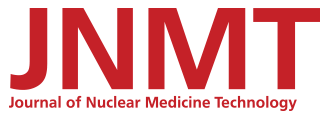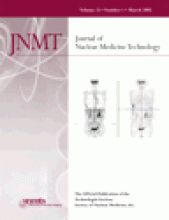Abstract
Objective:
We retrospectively analyzed the safety, cost effectiveness, and patient acceptance of outpatient high-dose 131I treatment for thyroid cancer at our hospital since 1997, when the Nuclear Regulatory Commission began allowing high-dose outpatient therapy with radioiodine.
Methods:
Forty-eight patients were treated as outpatients because their living conditions were acceptable and they were willing to comply with radiation safety guidelines. The homes of 3 patients were surveyed for contamination. The cost of outpatient treatment was compared with the cost of inpatient treatment. Patient acceptance was assessed by patient satisfaction surveys performed at the time of the posttherapy scan.
Results:
No levels of contamination above regulatory levels were found in patients’ homes. The cost of outpatient treatment was favorable. All surveyed patients were pleased with the procedure.
Conclusion:
If state and federal guidelines for releasing patients are followed, and if patients’ living conditions are adequately assessed, outpatient treatment with high-dose 131I is safe and cost effective and improves patient satisfaction.
Radioactive iodine has been used for more than 50 y for the treatment of thyroid diseases. To minimize exposure of the public to large doses of 131I (greater than 1,110 MBq, or 30 mCi) given for thyroid cancer, this therapy was routinely performed on an inpatient basis. In 1997, the Nuclear Regulatory Commission revised the criteria for radioiodine therapy and allowed patients to be treated as outpatients (1). The patient-release criteria changed from 1,110 MBq (30 mCi) of activity in a patient, or a dose rate of 0.05 mSv (5 mrem) per hour at 1 m from the patient, to a total effective dose equivalent of no more than 5 mSv (500 mrem) in any single year to a person in contact with a released patient (2). Theoretically, patients requiring doses as high as 9,250 MBq (250 mCi) could be discharged from the hospital immediately after receiving the radioiodine dose. Previously, patients treated with doses greater than 1,110 MBq (30 mCi) had to be hospitalized and isolated (3,4). Because the change was so dramatic, referring physicians felt uneasy not hospitalizing their patients for therapy even though studies proved that the radiation received by people in contact with these patients would not exceed allowable levels if the release guidelines limiting exposure of other individuals were followed (5). We retrospectively analyzed the safety, cost-effectiveness, and patient acceptance of outpatient treatment of thyroid cancer patients receiving large doses of radioactive iodine.
MATERIALS AND METHODS
Forty-eight thyroid cancer patients, who were between 14 and 88 y old, were treated with 131I as outpatients. The administered doses ranged from 3,034 to 9,250 MBq (82–250 mCi). The nuclear physician and radiation safety officer discharged patients on the basis of total effective dose equivalent (TEDE) calculations (using retained activity, an occupancy factor of 0.25 at 1 m, and effective and physical half-lives of thyroidal fraction), assessment of an individual patient’s living conditions, and the patient’s willingness to comply with limitations needed to keep the occupancy factor less than 0.25. Patients whose exposure levels were less than 5 mSv and who agreed to follow radiation safety instructions were discharged after treatment. Three patients, treated with 3,700, 5,500, and 7,400 MBq (100, 150, and 200 mCi), were surveyed at home on the fifth day after treatment. Exposure was measured at 0.3 and 1 m (1 and 3 ft) with a 3450P probe (Victoreen Co.). Radiation in the living room, bedroom, bathroom, and kitchen was surveyed using an E-120 with HP 360 probe (Eberline) (Table 1). The surveys and exposure levels were compared with levels obtained from hospitalized patients treated with the same doses. The costs of outpatient and inpatient treatments were compared. Patient acceptance was assessed by surveys performed when the patient returned for scanning at 7–10 d after therapy.
Exposure Rate Measurements
RESULTS
Radiation exposure and contamination surveys in the patients’ homes found no levels of contamination greater than regulatory levels. The exposure of household members ranged from 0.6 to 2.5 mR/h at 0.3 m (1 ft) and from 0.15 to 0.79 mR/h at 1 m (3 ft) (Table 1). Contamination levels ranged from undetectable to 183.6 disintegrations per minute (Table 2). One area of slight contamination was found in the home of a patient treated with 9,250 MBq (250 mCi). The area was decontaminated, and a wipe test then showed no removable contamination (Table 3). Survey results on the third posttreatment day in the home were compared with those in the hospital room for patients treated with 3,700, 5,500, or 9,250 MBq (100, 150, or 250 mCi). The exposure levels were within regulatory levels in both instances, with most contamination (still below regulatory levels) occurring in the bathroom.
Radiation Survey Results
Wipe Test Results
The costs of inpatient treatment were compared with the costs of outpatient treatment at the same doses (Table 4). The average daily cost was $550 more for inpatient treatment than for outpatient treatment. With most inpatients remaining in the hospital for 2 d, costs amounted to $1,100 more for inpatients than for outpatients.
Inpatient Costs vs. Outpatient Costs
Patients were surveyed when they returned for posttherapy scanning. Most reported no difficulties, and even complaints of nausea and sialoadenitis appeared to be less frequent. The contact information for the nuclear physicians had been given to patients in case they had questions, and 10% had called with minor concerns. No difficulties in complying with regulations were reported. Many patients had made arrangements for young children or pets to live apart for a few days and kept the occupancy factor to at least 0.25. All patients were pleased with the procedure and commented that they would choose outpatient treatment again.
DISCUSSION
Our retrospective analysis demonstrated that outpatient treatment with high doses of 131I is safe and cost effective. The levels of contamination were less than regulatory limits. Patients had no difficulty complying with requirements for radiation safety. Concerns about patients actually following regulations will always exist, but our surveys showed that if patients are selected with caution, there should be no problems with exposure of the public to radiation (6). Patient acceptance was high, and patients appeared to prefer this way of receiving radioiodine therapy.
Our criteria for release were based on state regulations and included calculations of TEDE and surveys of patients’ living conditions and ability to understand and follow safety directions. Our calculations assumed that patients treated with 131I for thyroid cancer had already undergone thyroidectomy and had no remaining thyroid tissue. Unfortunately, a small group of patients may have a significant amount of remaining thyroid tissue secondary to surgical difficulties. In these patients, thyroidal uptake is more than the standard 5%, markedly affecting the calculated TEDE. We believe that this group of patients needs to be studied further and probably should be treated within the hospital.
CONCLUSION
Outpatient radioiodine treatment is safe and cost effective and improves patient satisfaction. Thyroid cancer patients receiving large doses of 131I much prefer to be treated as outpatients, and they can be if state and federal criteria for release are followed, if their living conditions are adequate, and if they are willing to follow safety guidelines.
Footnotes
For correspondence or reprints contact: Leonie Gordon, MD, Department of Radiology, Medical University of South Carolina, 169 Ashley Ave., Box 250322, Charleston, SC 29425.
E-mail: gordonl{at}musc.edu







